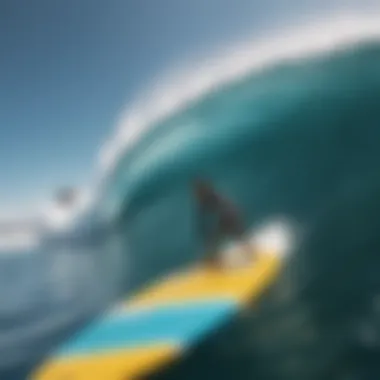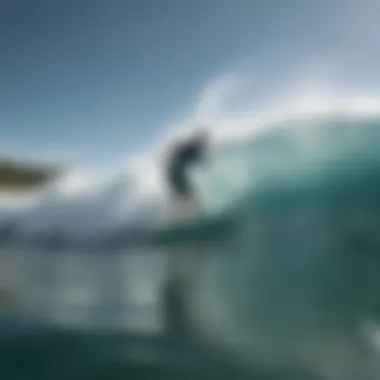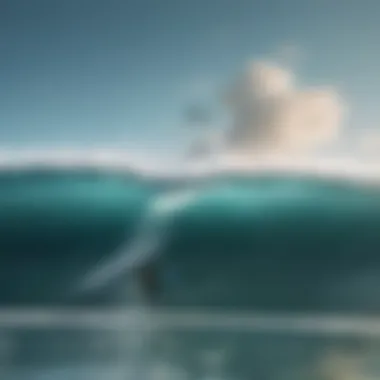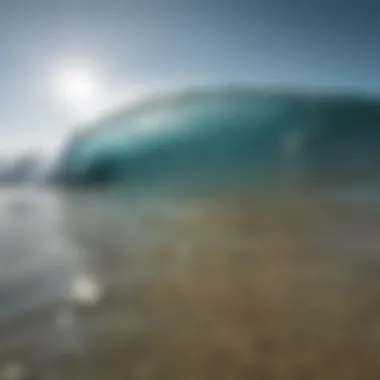Exploring the Salinity of Seawater: Causes and Effects


Intro
Salinity, the measure of salt concentration in seawater, is a critical component that can shape the behavior of oceans and its inhabitants. A few scoops of salt can actually make a world of difference, and understanding this element requires a deep dive into an intricate web of geological, atmospheric, and biochemical processes.
Seawater accounts for approximately 97% of our planet's water supply, and this high salinity level doesn’t just pop out of nowhere. It’s a result of various factors, such as the weather and even the activities of living creatures. So, why is it that some bodies of water taste saltier than others? What role does human activity play in shaping our oceans? These questions mark the beginning of our exploration into the salinity of seawater, forging a path to discovering how it underpins marine ecosystems and impacts ocean dynamics.
Throughout this article, we'll walk through the various reasons behind the salinity of seawater, breaking down everything from mineral influx to the effects of evaporation. With a keen eye on how these elements interact, we aim to enhance our understanding of why the oceans are salty and what that means for life within and around them. Let’s now move on to our first section, where we will explore the geological aspects of seawater salinity.
The Nature of Seawater Salinity
Seawater salinity is a cornerstone in understanding our oceans. Knowing why it matters isn't just a trivial pursuit; it's fundamental for a wide range of activities from oceanography to surfing. The salinity levels can influence everything from ocean currents to marine life, acting as a barometer of environmental health. Understanding this topic can aid in everything from effective fishing practices to ensuring the right conditions for surfing.
Definition of Salinity
Salinity, in the simplest terms, refers to the concentration of salts in seawater. It’s usually denoted in practical salinity units (PSU) or as a percentage. Typical seawater contains about 35 grams of dissolved salts per liter, making it a saline solution. This mix primarily consists of sodium chloride, but you’ll also find contributions from magnesium, calcium, potassium, and a variety of other ions.
Salinity isn’t static; it alters based on several factors, including evaporation rates, precipitation, and freshwater inputs from rivers. This variability adds complexity to marine ecosystems, as different species adapt to various salinity levels, making the ocean's saline mix a living, changing entity.
Measuring Salinity
To dive into understanding the dynamics of salinity, measuring it becomes essential. There are several methods employed to gauge salinity levels, each with its own merits.
- Conductivity Measurement: One of the most common techniques involves measuring the electrical conductivity of seawater. The more dissolved salts present, the higher the conductivity.
- Hydrometer: This traditional tool floats in water, giving a reading based on how much it sinks. Salinity readings can be derived from its displacement.
- Refractometer: Similar to a hydrometer, a refractometer uses light refraction to calculate salinity. It’s often used by sailors and divers for quick readings.
While these methods differ, they all rely on the same fundamental principle: salts influence physical properties of seawater. It is crucial for various stakeholders, from researchers tracking ocean health to surfboarders wanting the ideal wave conditions, to understand what these readings signify.
Salinity is not the static number often believed; it's influenced by a variety of environmental factors and can change from one area to another in a heartbeat.
Sources of Salinity
The salinity of seawater is not merely a random occurrence but rather the result of multiple sources that contribute to the saltiness of our oceans. Understanding these sources is essential for grasping how the marine environment operates and why it is crucial for various forms of life, including humans. Each source brings its own significance, impacting everything from ocean circulation to marine biodiversity.
Rivers and Runoff
Rivers are like the blood vessels of our planet, transporting not just freshwater but also a variety of minerals and salts. As rivers flow from land to sea, they gather dissolved solids from the soil and rock along their banks. This runoff becomes particularly relevant in areas with high agricultural activity, where fertilizers can enrich the water with additional nutrients and salts.
- As rain hits the ground, it collects minerals and organic matter.
- When rivers empty into the sea, they add to the overall salinity of the coastal waters.
- This process can vary from region to region, depending on climate and human activities.
The dilution factor is also important. The more freshwater enters the sea from rivers, the less saline the surface layers are likely to be. However, in estuarine regions, mixing zones form distinct salinity gradients that create diverse ecosystems. These dynamics illustrate how river input plays a critical role in not just salinity, but the overall health of marine ecosystems.
Volcanic Activity
Volcanic activity may seem distant from the ordinary surfer's day at the beach, yet it has a fascinating influence on seawater salinity. Underwater volcanoes, also called submarine volcanoes, release ash, gases, and minerals directly into the ocean. When these eruptions occur, they provide important elements like chlorine, magnesium, and sodium, which contribute to the ocean's salinity.
- Emission of volcanic gases such as sulfur dioxide dissolves in ocean water, forming acids that can further react with minerals.
- Minerals released during eruptions can increase the salinity of local waters, especially in remote areas.
- Over geological time, the continuous release of materials from volcanic activity has steadily influenced the mineral composition of oceans.
Through these actions, volcanic activity not only enriches the seawater but also impacts marine life by altering chemical balances necessary for various species to thrive.


Atmospheric Contributions
The atmosphere stands as another player in the salinity game, influencing oceans in a myriad of ways. Salt particles from sea spray and atmospheric deposition play a crucial role in the salinity dynamics. When winds whip up waves, they cast tiny droplets of seawater into the air, which can carry salt far inland or even contribute to cloud formation.
- Rainwater can be a double-edged sword. While it can dilute seawater salinity, it might also contain salts and particles deposited from the atmosphere.
- In coastal areas, atmospheric conditions can lead to higher salinity levels due to evaporation, which concentrates salts in surface waters.
- Industrial activities, dust storms, and human pollution can introduce new types of salts into ocean waters, further complicating salinity levels.
"The interconnection between the ocean and atmosphere is a symbiotic relationship; changes in one invariably affect the other."
By examining these atmospheric components closely, we deepen our understanding of how wide-ranging factors shape the salinity of seawater, influencing everything from marine biodiversity to global weather patterns.
Understanding these sources of salinity provides valuable insight for researchers, ecologists, and even travel planners looking to understand marine ecosystems better. Every drop of seawater holds a story of interactions—be it from mountains, volcanoes, or the skies—adding to the intricate tapestry that sustains life within our oceans.
Chemical Processes Influencing Salinity
The salinity of seawater isn’t merely a number; it’s a dynamic interplay of various chemical processes that shape marine environments. Understanding these processes is crucial not just for marine biologists but also for surfboarders, marketers, and travel planners who rely on aquatic ecosystems for their livelihoods. Each process—dissolution of minerals, evaporation, and precipitation—plays a vital role in determining the salinity levels in our oceans.
A nuanced grasp of these mechanisms offers insight into how salinity fluctuations impact marine life and overall ocean health. It’s like delving into the recipe of a complex dish—every ingredient matters and interacts, sometimes unexpectedly, leading to shifts in taste—or in this case, ecological balance.
Dissolution of Minerals
Minerals are basically the bedrock of seawater's salinity. As water from rivers and streams flows into the ocean, it carries with it numerous dissolved minerals. This process is called mineral dissolution. Silica, calcium, and sodium are some of the big players here.
Through weathering of rocks and volcanic activity, these minerals enter water bodies, contributing to the salty brew we know as seawater. It’s not a straightforward jump; the interactions between minerals and water are complex. For instance, sodium and chloride ions, which combine to form common salt, enter the ocean mainly through rivers.
Moreover, these dissolved minerals can have varying effects on ocean health. Higher concentrations can lead to nutrient richness, promoting a vibrant ecosystem, while lower levels may cause strife among marine organisms.
"The ocean is like a vast kitchen; the minerals are key ingredients that define its flavor and appeal."
Evaporation and Concentration
Another crucial element impacting salinity is evaporation. When the sun beats down on ocean waters, it essentially pulls moisture up into the atmosphere. This change is often more than just a simple phase transition; it leaves behind a concentrated mix of salts in the ocean. Where there's a surplus of heat—think equatorial regions—the evaporation rates spike.
As the water evaporates, the dissolved salts stay put, which leads to an increase in salinity. This phenomenon has a direct tie to local climates. For instance, bodies of water like the Dead Sea show incredibly high salinity levels because evaporation rates far exceed inflow from rivers.
Additionally, this process influences not just salinity but also the local weather patterns, which can create feedback loops affecting regional ecosystems and even human activities such as fishing and tourism.
Precipitation and Dilution
On the flip side of evaporation lies precipitation, another critical process. Rain, while essential for life, can dilute the salinity levels of seawater. When rain falls into the ocean, it can introduce freshwater, leading to a reduction in salinity, especially in areas where rivers meet the sea.
This phenomenon isn’t uniform; it depends on geographical location, weather patterns, and seasonal changes. For example, during heavy rainfall seasons, estuaries—where freshwater mixes with saltwater—often experience significant drops in salinity.
Understanding how precipitation influences salinity helps highlight its crucial role in maintaining marine ecosystems. If the salinity dips too low, it can have adverse effects on marine life that thrives under specific salinity conditions.
In sum, the interplay between these chemical processes—mineral dissolution, evaporation, and precipitation—creates a complex web that influences the salinity of our oceans. Knowledge of these dynamics is essential for those engaged in the marine environment, whether for ecological studies, business developments, or personal pursuits such as surfing.
The Role of Oceanic Circulation


Oceanic circulation plays a crucial role in shaping the salinity of seawater, acting as a dynamic system influencing how salt is distributed across the globe's oceans. This section dives into the mechanics behind oceanic currents, their impact on salinity levels, and why they are essential for maintaining the health of marine ecosystems.
Thermohaline Circulation
Thermohaline circulation, often dubbed the "global conveyor belt," is primarily driven by variations in water density, which is influenced by temperature and salinity. In simpler terms, the warmer, saltier water tends to be less dense than the cooler, fresher water. When water cools or experiences increased salinity, it becomes denser and sinks, creating a cycle of movement throughout the ocean. This process regulates not only salinity but also the temperature of oceanic regions, which is vital for sustaining diverse marine life.
Imagine the ocean as a massive, interconnected system where surface waters warm up in tropical regions and then travel towards the poles. As this warmer water loses heat to the atmosphere and interacts with colder regions, it increases density and begins its descent into the depths. The cold water then travels vast distances in the ocean's abyss before rising back up elsewhere, often in areas where coastal upwelling occurs. Such circulation patterns are fundamental, directly impacting how salinity fluctuates in different ocean areas, highlighting the sea's perpetual motion.
Influence on Temperature and Salinity Distribution
The impact of oceanic circulation on the distribution of temperature and salinity cannot be overstated. Differing salinity levels lead to unique marine environments, each supporting specific forms of life. As currents flow, they carry with them varying concentrations of salt and temperature. For instance, warm, salty water currents can influence coastal climates, while cold, denser water contributes to upwelling, bringing nutrients from the depths back to the surface.
"Oceanic circulation is not just about the movement of water; it's about transporting life, nutrients, and heat across the planet."
The interaction of currents is a delicate dance, significantly affecting fishing industries and coastal communities. Fishermen, for instance, must understand these currents to optimize their catch. Many species, such as certain fish and plankton, have strengthened survival traits, adapting to the specific salinity and temperature conditions created by these currents, thus forming a balanced ecosystem.
Some key influences of oceanic circulation include:
- Dispersion of nutrients: Upwelling that occurs in areas with certain currents revitalizes marine habitats by providing nutrients necessary for the growth of phytoplankton, the foundation of the marine food web.
- Regulation of climate: Circulation patterns can moderate temperature in coastal regions, creating conditions that either support or hinder aquatic life.
- Alteration of local salinity levels: Strong currents can bring saltier water into estuaries, affecting the local brackish water ecosystem.
Historical Context of Seawater Composition
Understanding the historical context of seawater composition is crucial for grasping the intricate dynamics of salinity. This section aims to unpack the origins of our oceans and how they have evolved over geologic time, drawing connections to present realities. Historical salinity levels hold valuable clues about Earth’s climate and geological changes, relevant not just to marine biologists but also to surfboarders, marketers, and travel planners who seek a deeper understanding of oceanic conditions.
Formation of the Oceans
The formation of the oceans is a fascinating tale that stretches back over four billion years. Initially, the planet was a molten mass, with no liquid water in sight. Over time, as the Earth cooled, volcanic activity released steam and gases. This process, often depicted as the outgassing from the Earth's mantle, contributed to the formation of the early atmosphere.
When cooler temperatures allowed for condensation, it started raining— for millions of years. This primordial rain filled the low-lying basins, eventually giving birth to the oceans we know today. What's key to note here is that as these bodies of water formed, they began to collect minerals and salts from volcanic eruptions and rocks on land through runoff.
Salinity levels weren't fixed; they were shaped by chemical reactions.
- Role of minerals: The dissolution of minerals from surrounding rocks added various salts, fundamentally influencing the salinity.
- Impact of gases: Notably, elements such as sodium and chloride were introduced into the water as rocks worn away over the eons.
This blend of minerals became the base for the salinity we observe in oceans today. Imagine standing on a surfboard and feeling the marine life around you; it all started with this initial concoction.
Biological Impact of Salinity
The biological impact of salinity is crucial for understanding the intricate relationship between marine ecosystems and their salty environment. It influences the behavior, physiology, and distribution of marine organisms. As the salinity levels in seawater fluctuate due to various environmental factors, such as climate change or freshwater influx from rivers, the implications for marine life can be profound. Not only does salinity affect the health of individual species, but it is also a key determiner of biodiversity and the overall productivity of aquatic habitats.
Marine organisms have evolved numerous mechanisms to contend with the varying salinity levels found in their environments. These adaptations ensure that life continues to thrive in conditions that can be quite harsh. For surfers and travel planners who enjoy the ocean, understanding these adaptations can enhance awareness of local waters and enhance the appreciation of the biological richness beneath the waves.
"Salinity levels can often dictate which species inhabit a given region, making it a cornerstone of marine biology."
Adaptations of Marine Life
Marine life has developed a fascinating array of adaptations to cope with varying salinity levels. These adaptations can be classified into several categories:


- Osmoregulation: Many marine organisms actively regulate their internal salt concentrations to prevent dehydration caused by high salinity. For instance, fish that live in salty waters, such as the mullet, possess specialized cells in their gills that help expel excess salt.
- Behavioral Changes: Some species, like certain crustaceans, exhibit behavioral adaptations by migrating between salinity zones as needed. This migratory behavior ensures they remain in optimal environments for survival.
- Physiological Tolerance: Species such as the mangrove snapper have shown remarkable physiological resilience to salinity fluctuations. They can survive in a range of salinity levels, making them more adaptable in transitioning environments.
Understanding these adaptations can help in conservation efforts, as changes in salinity can threaten these delicate mechanisms.
Salinity Tolerance in Different Species
Salinity tolerance varies widely among marine species, impacting nutrient availability and community dynamics within the ecosystem. Some species thrive in extreme salinity conditions, while others may struggle to survive outside their preferred salinity range.
- Euryhaline Species: These organisms, such as the bull shark, can tolerate a wide salt concentration range, allowing them to inhabit brackish waters where river and ocean meet. Their flexibility gives them an edge in fluctuating environments.
- Stenohaline Species: In contrast, organisms like many coral species are stenohaline. They can only survive within a narrow salinity band. Salinity changes can severely impact their health and population, leading to increased mortality rates and a decline in biodiversity in coral reefs.
- Salinity and Aquaculture: For marketers and those in travel planning, recognizing the importance of salinity tolerance is crucial for sustainable aquaculture practices. Understanding which species thrive in specific salinity conditions can inform decisions on fish farming methods and locations, contributing to more effective and environmentally responsible operations.
The Implications of Salinity Variability
Understanding the implications of salinity variability is crucial for marine scientists, surfers, and anyone who relies on the ocean's resources. This section digs into the connections between changing salinity levels and various ecological and sociological dynamics. Salinity isn't just a number; it's a complex factor that can significantly influence marine life, local economies, and even global climate patterns.
Climate Change Effects
The ongoing changes in our climate are not just warming our planet but also altering salinity patterns across the world's oceans. Sea levels are rising, ice caps are melting, and intense weather events varying from flooding to drought are changing the flow of freshwater into our salty seas.
As freshwater dilutes ocean salinity, it has several noteworthy consequences:
- Hotspots of Biodiversity: Changes in salinity affect nutrient availability. Areas with high salinity often support diverse marine ecosystems. When salinity levels fluctuate, these ecosystems can either flourish or suffer drastically.
- Altered Climate Systems: Ocean circulation patterns shift with changing salinity, which has a domino effect on global climates. The flow of warm and cold water currents can change weather patterns, impacting agriculture and local weather.
- Ocean Acidification: Increased CO2 levels, connected to climate change, lead to higher acidity in seawater. This, in combination with variable salinity, can severely affect calcifying organisms like corals and shellfish, which play vital roles in marine ecosystems.
"Climate change is reshaping ocean salinity in ways that have profound implications for marine biodiversity and human livelihoods."
Marine ecosystems are finely tuned to specific salinity ranges. Abrupt changes can lead to notable stresses on these systems, influencing fish migrations and breeding cycles. It’s a ripple effect that goes well beyond the shoreline.
Local Ecosystems and Fishermen
Local ecosystems and the livelihoods they sustain are intricately connected with salinity levels. Fishermen, in particular, are often the first to notice these changes. When salinity shifts, it impacts species distribution, breeding grounds, and ultimately, fish stocks.
- Shifting Fish Populations: Species like salmon and cod are sensitive to salinity changes. As their habitats shift due to variability, fishermen may find it challenging to locate the stocks they once depended on.
- Economic Implications: Fishermen's incomes can fluctuate with the availability of fish, leading to economic instability in coastal communities. This might cause fishermen to rethink their fishing strategies, gear, or even fish monitoring technology, which requires ongoing adaptation to the ever-changing environment.
- Biodiversity Loss: Critical species may disappear from local areas if salinity levels become too extreme for them to thrive. Loss of certain fish can disrupt the entire food web, impacting not just marine life but also the broader coastal economies.
Understanding these implications is essential for developing strategies to manage fisheries sustainably and for advocating for policies that address climate change impacts on our oceans.
The shifting salinity dynamics embody a complex interplay of ecological frameworks, economic activities, and environmental policies. Recognizing the stakes involved, both for nature and humankind, is vital as we explore avenues to mitigate these changes.
Summary of Seawater Salinity Dynamics
The salinity of seawater is not just a number on a gauge; it’s the very lifeblood of marine ecosystems and a crucial player in the planet's broader climate system. Understanding the dynamics of seawater salinity can illuminate how oceanic conditions affect everything from the weather patterns we experience to the health of coral reefs.
This summary serves as a bridge that connects various aspects discussed in the article. It highlights key elements like the intricate balance of salinity influenced by geological formations, biological activities, and even atmospheric phenomena. Furthermore, it emphasizes the importance of this understanding for surfers, marketers, and travel planners alike, allowing them to navigate both the literal and metaphorical waters of their respective fields.
Key Takeaways
- Salinity Fluctuations: Seawater salinity is subject to change due to factors such as rainfall, evaporation, and river runoff, which highlights the ocean's dynamic nature.
- Biological Significance: Different marine organisms have varying tolerances to salinity, meaning shifts can impact biodiversity substantially. This knowledge is vital for conservationists and fisheries.
- Climate Connections: Salinity plays a pivotal role in climate regulation. Its variance has implications for ocean circulation patterns, which in turn influence global weather systems.
- Adaptive Strategies: Understanding how organisms adapt to salinity changes can offer insights into the resilience of marine species, an essential consideration for biodiversity management.
Future Research Directions
Research into seawater salinity remains a field ripe for exploration. Here are some lines along which future studies could unfold:
- Impact of Climate Change: As global temperatures rise, understanding how salinity profiles will shift—both locally and globally—is paramount.
- Technological Innovations: Employing cutting-edge technology, like remote sensing and AI, could enhance our ability to monitor salinity changes in real time, leading to more informed decisions.
- Ecosystem Interactions: Further investigating how changes in salinity affect marine food webs could yield crucial insights into ecosystem health and resilience.
- Salinity and Human Activities: Examining how urban runoff and industrial activities alter local salinity levels could inform better management practices to protect coastal environments.
In closing, the dynamics of seawater salinity encompasses a wide array of critical factors that warrant continuous study and attention. Whether for academic inquiry or practical application in surf forecasting and marine tourism, the stakes are high. Keeping tabs on salinity ensures a better understanding of our oceans today and for future generations.















